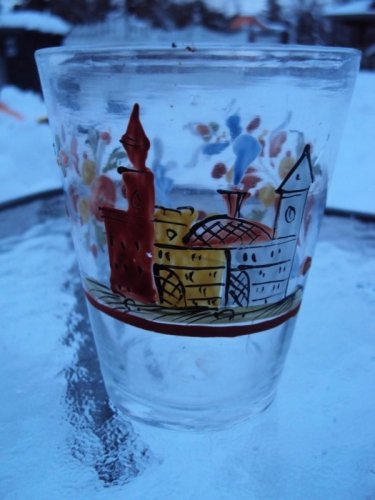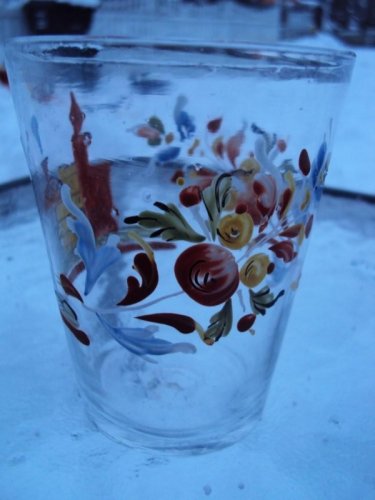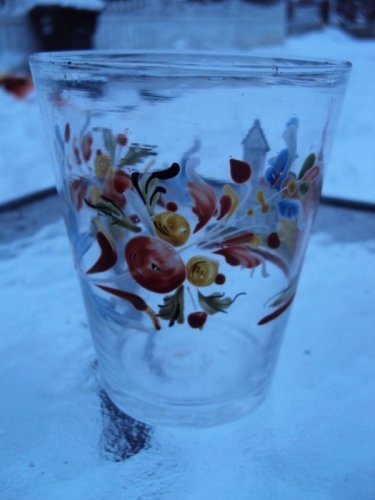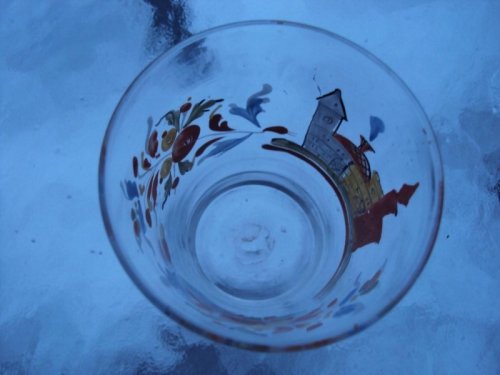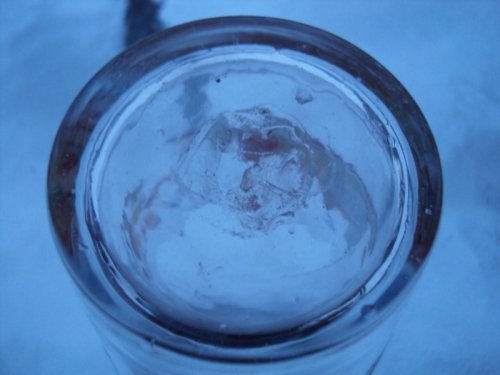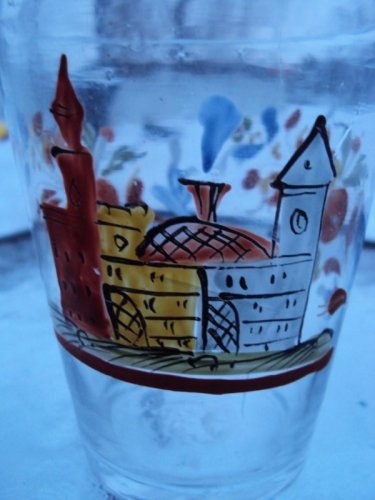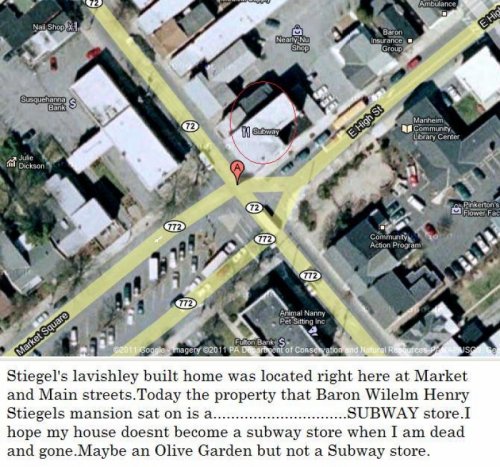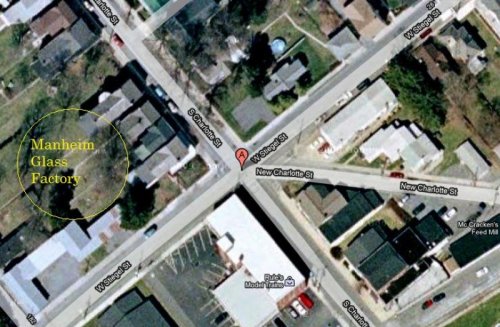Steve/sewell
Well-Known Member
- Joined
- Jan 23, 2010
- Messages
- 6,108
- Reaction score
- 5
- Points
- 0
I am ecstatic to now own the following piece of glass:[ ]
]
The newest piece of glass to my collection is a flint glass tumbler which I feel very strongly was made at the Manheim Pennsylvania glass works of Wilhelm Henry Stiegel between the years of 1765 and 1773.The glass or tumbler is 4 inches tall 3 inches wide at the top and 2 inches wide at the bottom colorless and decorated with a glass factory other buildings and chimneys on one side and roses,tulips,apples and pomegranates on the rest of the glass.There is a rough pontil and other debris and potstones scattered through out the rest of the glass.
The part that links this glass to Stiegels factory is the painting itself.Stiegels factory has been described by many glass historians as being a massive domed 90 foot tall 120 feet by 120 feet building made of solid English brick.If you look closely at the relief on the glass it clearly depicts a large domed red brick colored roof in the center of the mural bounded by two chimneys billowing a great deal of smoke.This is key as just like the Jenny Lind calabash bottles 90 years later depicted a glass house with smoke flumes. The smoke is an integral part of the painting as each is large in the relief.Why would the artist bother portraying smoke when a chimney is easily recognizable. On the bottom of the mural are a white building and a yellow building shaped like an airport hanger but also resembling early drawings of glass works.
When the glass arrived and I showed my wife the picture on the glass the first comment from her was hey look at the smoke coming from the chimneys that's really cute.The first thing I noticed was the domed roof.The domed roof was the one thing you noticed from 10 miles away as you approached Manheim.The piece has all of the early traits as to being manufactured at the time of Stiegels operation.The style and the motif of the painting resembles other work done by Sebastian Witmer one of Stiegels 4 glass enamelers.I own other glasses and toiletry bottles painted by Sebastian and the decor is virtually identicle.Here is one historians account of the founding of the Stiegel glass works.
Manheim Founded.
In February, 1762, Charles and Alexander Stedman, merchant and lawyer of Philadelphia, purchased a tract of land containing 729 acres and allowances from Isaac Norris and his wife Sarah. This land had been claimed in 1733 by James Logan, which upon his death reverted to Norris, a son-in-law of Logan. The Baron had become intimately acquainted with these men during the recent prosperous years and the Stiegel Company was formed, the Baron paying 50 lbs. sterling for his one-third interest. This partnership was formed in September, 1762. Toward the close of the year the Baron, who was highly educated and a fine surveyor, divided this tract into lots, with streets and alleys, for the purpose of erecting a town which be named and laid out after the city from which he came, "Manheim."
On this beautiful spot on the north bank of the Chickies Creek we find the now Manheim of today, the finest and most healthful country town in Pennsylvania, fashioned and shaped after the city whose name it bears beyond the dark blue seas. The Baron's idle dreams of one hundred and thirty-four years ago are slowly but surely maturing. When this town was founded there were only two houses in it and these were little log structures. Stiegel himself was the first to build a house on the ground laid out Work on this house was commenced early in 1763, but it was not finished till 1765. It was erected on the northeast corner of Market Square and East High street in the form of a large square; TODAY THE SITE IS A SUBWAY DELI STORE,each side was forty feet long made of red brick which were imported from England and hauled from Philadelphia by the Baron's teams.
This in all probability accounts for the long time required in building. The plain neighbors called it a "Mansion" also. This building had two floors. The second floor was divided into three parts by halls; the half of it on the south side was arched and constituted the famous " chapel " which contained a pulpit from which the Baron was wont to teach to his working men and others at times the doctrines or the Lutheran faith in the German language. The other half was divided into two apartments, front and rear. The former had beautiful decorations of tiles with scriptural texts and scenes about the mantles. The same division of rooms by hallways was had down stairs; the great parlor was hung with tapestry on which were painted hunting scenes, life-size, with falcons. Some of this tapestry is still in the hands of Mr. Arndt, the present owner, but the largest part is safely in the Pennsylvania Historical Society's rooms in Philadelphia.
The mantles were also adorned with beautiful blue tiles and heavy woodwork doors, wainscoting, etc. This was the most handsome parlor in the community, excelled by very few in the city. Back of this room was the dining hall and back of it the kitchens. The house was two-storied and on the roof surmounting the whole was the gigantic cupola extending from chimney to chimney, to which the workmen repaired to entertain the Baron with sweet strains of music. Inside the house were found remaining in after years the finest chinaware, telling of the high aspirations of the people who once resided there. About the time this house was finished the Baron brought his family from Philadelphia, to Elizabeth, this being a larger place than Mannheim.
Glass Works
The success at Elizabeth Furnace made the naturally enterprising Baron still more so. It was quite evident to him that his embryonic town could not grow without the stimulus of some industries. Consequently between the years 1765 and 1768 he erected a glass factory on the northwest corner of Stiegel and Charlotte streets. This factory was so large that a four-horse team could easily turn around in it and come out at the place of entrance. (It was built of the same imported brick, ninety feet high, in the shape of a dome) . The manufacture of glass was commenced In the latter part of the year 1768. (Early in this year he gave a mortgage on his one-third of all the properties of the company, 14,078 acres of land, for 93,000 to Daniel Benezet).
Skilled work-men were brought from Europe to carry on the work. In 1769 the factory was run to its fullest capacity, employing thirty- five men. A very interesting agreement with a decorator can be seen in Mr. Danner's relic room. The stipulations are that he shall do first- class work in hand painting and receive 40 lbs.silver spanish milled coins yearly, house roxit and firewood for said services. The products of this factory were vases, sugar and finger bowls, salts, flasks, pitchers, tumblers, wine glasses of every imaginable shape; toys and scores of other articles were manufactured in various colors and hand painted. Much of this superior glassware is still in existence, and quite a large part of it is in the hands of relic hunters. This ware has a characteristic ring that puts all imitations and impostors to shame. August 4, 1769, the Stedmans sold their interest in the 769 acres upon which the town of Manheim stands to Isaac Cox, who on February 1, 1770, sold the same to the Baron for 107 lbs.silver and ten shillings. This gave him the sale ownership of Manheim.
The Baron very soon after this moved his family from Elizabeth Furnace to the stately mansion already described, which he had completed five years before. At this time, 1769 and 1770, the Baron was considered one of the wealthiest and most influential men in Pennsylvania. He had invested all of the 40,000 lbs of silver which he bad brought with him from the old country in tracts of land in many parts of the State under the title of the Stiegel Company. He had 200 to 300 men employed; Elizabeth Furnace was in a flourishing condition. Stoves were sent out to all parts of the inhabited country. The other furnaces and forges in which Stiegel had an interest, as well as the glass factory, were run to their greatest capacity, the glassware was carried into the markets of Boston, Philadelphia and New York.
Quite a portion, fortunately, was sold about home. The Baron was accumulating wealth which made him still more ambitious. He lived very extravagantly and invested freely in almost anything to which his attention was called by a friend. He was in the habit of inviting his city and country friends to a banquet at the mansion at Elizabeth, or the chateau at Manheim.
I really feel this piece is a product of the Flint glass factory of Wilhelm Henry Stiegel and actually depicts the important glass works in the day.[ ]
]

The newest piece of glass to my collection is a flint glass tumbler which I feel very strongly was made at the Manheim Pennsylvania glass works of Wilhelm Henry Stiegel between the years of 1765 and 1773.The glass or tumbler is 4 inches tall 3 inches wide at the top and 2 inches wide at the bottom colorless and decorated with a glass factory other buildings and chimneys on one side and roses,tulips,apples and pomegranates on the rest of the glass.There is a rough pontil and other debris and potstones scattered through out the rest of the glass.
The part that links this glass to Stiegels factory is the painting itself.Stiegels factory has been described by many glass historians as being a massive domed 90 foot tall 120 feet by 120 feet building made of solid English brick.If you look closely at the relief on the glass it clearly depicts a large domed red brick colored roof in the center of the mural bounded by two chimneys billowing a great deal of smoke.This is key as just like the Jenny Lind calabash bottles 90 years later depicted a glass house with smoke flumes. The smoke is an integral part of the painting as each is large in the relief.Why would the artist bother portraying smoke when a chimney is easily recognizable. On the bottom of the mural are a white building and a yellow building shaped like an airport hanger but also resembling early drawings of glass works.
When the glass arrived and I showed my wife the picture on the glass the first comment from her was hey look at the smoke coming from the chimneys that's really cute.The first thing I noticed was the domed roof.The domed roof was the one thing you noticed from 10 miles away as you approached Manheim.The piece has all of the early traits as to being manufactured at the time of Stiegels operation.The style and the motif of the painting resembles other work done by Sebastian Witmer one of Stiegels 4 glass enamelers.I own other glasses and toiletry bottles painted by Sebastian and the decor is virtually identicle.Here is one historians account of the founding of the Stiegel glass works.
Manheim Founded.
In February, 1762, Charles and Alexander Stedman, merchant and lawyer of Philadelphia, purchased a tract of land containing 729 acres and allowances from Isaac Norris and his wife Sarah. This land had been claimed in 1733 by James Logan, which upon his death reverted to Norris, a son-in-law of Logan. The Baron had become intimately acquainted with these men during the recent prosperous years and the Stiegel Company was formed, the Baron paying 50 lbs. sterling for his one-third interest. This partnership was formed in September, 1762. Toward the close of the year the Baron, who was highly educated and a fine surveyor, divided this tract into lots, with streets and alleys, for the purpose of erecting a town which be named and laid out after the city from which he came, "Manheim."
On this beautiful spot on the north bank of the Chickies Creek we find the now Manheim of today, the finest and most healthful country town in Pennsylvania, fashioned and shaped after the city whose name it bears beyond the dark blue seas. The Baron's idle dreams of one hundred and thirty-four years ago are slowly but surely maturing. When this town was founded there were only two houses in it and these were little log structures. Stiegel himself was the first to build a house on the ground laid out Work on this house was commenced early in 1763, but it was not finished till 1765. It was erected on the northeast corner of Market Square and East High street in the form of a large square; TODAY THE SITE IS A SUBWAY DELI STORE,each side was forty feet long made of red brick which were imported from England and hauled from Philadelphia by the Baron's teams.
This in all probability accounts for the long time required in building. The plain neighbors called it a "Mansion" also. This building had two floors. The second floor was divided into three parts by halls; the half of it on the south side was arched and constituted the famous " chapel " which contained a pulpit from which the Baron was wont to teach to his working men and others at times the doctrines or the Lutheran faith in the German language. The other half was divided into two apartments, front and rear. The former had beautiful decorations of tiles with scriptural texts and scenes about the mantles. The same division of rooms by hallways was had down stairs; the great parlor was hung with tapestry on which were painted hunting scenes, life-size, with falcons. Some of this tapestry is still in the hands of Mr. Arndt, the present owner, but the largest part is safely in the Pennsylvania Historical Society's rooms in Philadelphia.
The mantles were also adorned with beautiful blue tiles and heavy woodwork doors, wainscoting, etc. This was the most handsome parlor in the community, excelled by very few in the city. Back of this room was the dining hall and back of it the kitchens. The house was two-storied and on the roof surmounting the whole was the gigantic cupola extending from chimney to chimney, to which the workmen repaired to entertain the Baron with sweet strains of music. Inside the house were found remaining in after years the finest chinaware, telling of the high aspirations of the people who once resided there. About the time this house was finished the Baron brought his family from Philadelphia, to Elizabeth, this being a larger place than Mannheim.
Glass Works
The success at Elizabeth Furnace made the naturally enterprising Baron still more so. It was quite evident to him that his embryonic town could not grow without the stimulus of some industries. Consequently between the years 1765 and 1768 he erected a glass factory on the northwest corner of Stiegel and Charlotte streets. This factory was so large that a four-horse team could easily turn around in it and come out at the place of entrance. (It was built of the same imported brick, ninety feet high, in the shape of a dome) . The manufacture of glass was commenced In the latter part of the year 1768. (Early in this year he gave a mortgage on his one-third of all the properties of the company, 14,078 acres of land, for 93,000 to Daniel Benezet).
Skilled work-men were brought from Europe to carry on the work. In 1769 the factory was run to its fullest capacity, employing thirty- five men. A very interesting agreement with a decorator can be seen in Mr. Danner's relic room. The stipulations are that he shall do first- class work in hand painting and receive 40 lbs.silver spanish milled coins yearly, house roxit and firewood for said services. The products of this factory were vases, sugar and finger bowls, salts, flasks, pitchers, tumblers, wine glasses of every imaginable shape; toys and scores of other articles were manufactured in various colors and hand painted. Much of this superior glassware is still in existence, and quite a large part of it is in the hands of relic hunters. This ware has a characteristic ring that puts all imitations and impostors to shame. August 4, 1769, the Stedmans sold their interest in the 769 acres upon which the town of Manheim stands to Isaac Cox, who on February 1, 1770, sold the same to the Baron for 107 lbs.silver and ten shillings. This gave him the sale ownership of Manheim.
The Baron very soon after this moved his family from Elizabeth Furnace to the stately mansion already described, which he had completed five years before. At this time, 1769 and 1770, the Baron was considered one of the wealthiest and most influential men in Pennsylvania. He had invested all of the 40,000 lbs of silver which he bad brought with him from the old country in tracts of land in many parts of the State under the title of the Stiegel Company. He had 200 to 300 men employed; Elizabeth Furnace was in a flourishing condition. Stoves were sent out to all parts of the inhabited country. The other furnaces and forges in which Stiegel had an interest, as well as the glass factory, were run to their greatest capacity, the glassware was carried into the markets of Boston, Philadelphia and New York.
Quite a portion, fortunately, was sold about home. The Baron was accumulating wealth which made him still more ambitious. He lived very extravagantly and invested freely in almost anything to which his attention was called by a friend. He was in the habit of inviting his city and country friends to a banquet at the mansion at Elizabeth, or the chateau at Manheim.
I really feel this piece is a product of the Flint glass factory of Wilhelm Henry Stiegel and actually depicts the important glass works in the day.[


